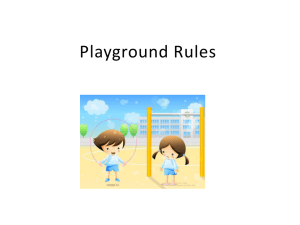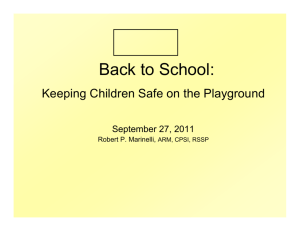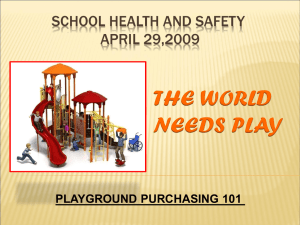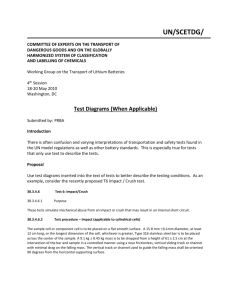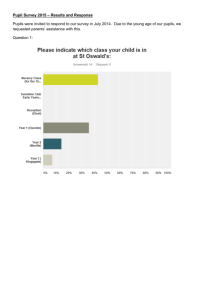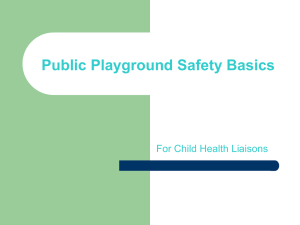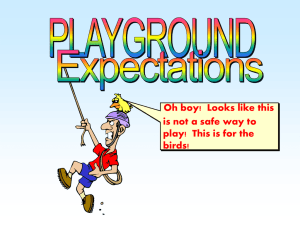Playgrounds Priority Items
advertisement
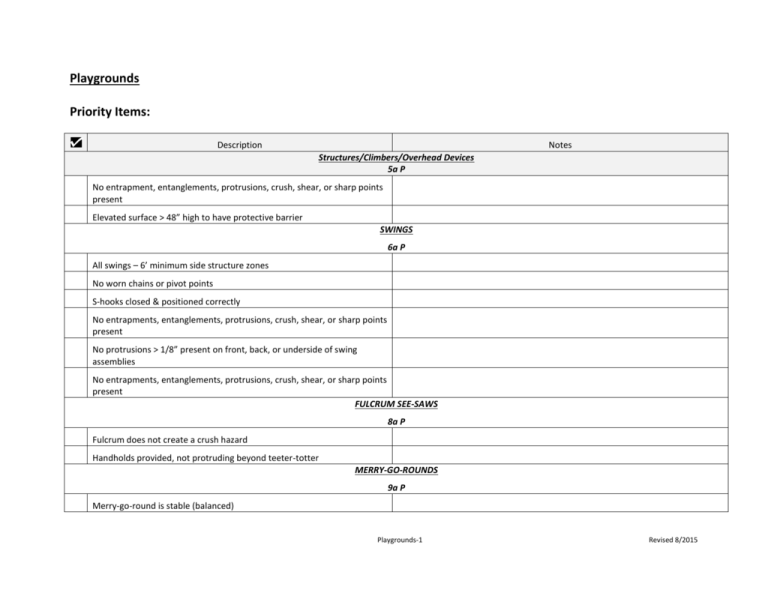
Playgrounds Priority Items: Description Notes Structures/Climbers/Overhead Devices 5a P No entrapment, entanglements, protrusions, crush, shear, or sharp points present Elevated surface > 48” high to have protective barrier SWINGS 6a P All swings – 6’ minimum side structure zones No worn chains or pivot points S-hooks closed & positioned correctly No entrapments, entanglements, protrusions, crush, shear, or sharp points present No protrusions > 1/8” present on front, back, or underside of swing assemblies No entrapments, entanglements, protrusions, crush, shear, or sharp points present FULCRUM SEE-SAWS 8a P Fulcrum does not create a crush hazard Handholds provided, not protruding beyond teeter-totter MERRY-GO-ROUNDS 9a P Merry-go-round is stable (balanced) Playgrounds-1 Revised 8/2015 Platform surface is continuous with no openings allowing 5/16” diameter rod to pass through Platform underside 9” minimum, sitting surface 18” maximum No entrapments, entanglements, protrusions, crush, shear, or sharp points present (check undercarriage mechanism) SPRING ROCKERS 10a P No entrapments, entanglements, protrusions, crush, shear, or sharp points present (check spring mechanism) Non-Priority Items: Description Notes PLAN REVIEW 1N All equipment has acceptable fall zones & protective surfacing (triaxial accelerometer measures surfacing impact absorption) Multi-axis & single axis swings not attached to composite structure SUPERVISION 2b N On-site visual supervision present MAINTENANCE 3N School/district maintenance/inspection program specifies inspection frequency Procedure to address hazards on playground Playground meets CPSC Guidelines & ASTM Standards. Playground adequately fenced or protected from traffic Playgrounds-2 Revised 8/2015 Playground has proper drainage, free of tripping hazards or other hazards (broken glass, etc.) No exposed footings No overhead obstructions (cables, branches, etc.) less than 7’ from play surface Adequate means to contain resilient surfacing. Adequate resilient surfacing (9” minimum) Resilient surfacing not compacted or trenched Adequate structural integrity – no dry rot, split boards, etc. Soccer goals anchored to prevent tipping Children should not wear drawstrings, jewelry, etc. Tires properly drained. No exposed steel belts Surfaces generating excessive solar heat gain (slides, etc.) shaded or protected Maximum length of rope, cable or chain with unattached end is 7” STRUCTURES/CLIMBERS/OVERHEAD DEVICES 5N USE ZONE – 6’ minimum for each climber or event. (< 30” equipment = overlap 6’ zone; > 30” equipment & stationary = 9’ zone) No exposed footings No bars onto which a child could fall from higher than18” No upper body equipment higher than 84” Elevated surface > 30” high to have guardrail Protective infill between platforms requiring barriers Playgrounds-3 Revised 8/2015 Clearance from structure to sliding pole between 18” - 20” Climbing ropes anchored at both ends Climbing ropes anchored below level of playing surface Overhead rings maximum 7” chain length Dome angles are > 55 ̊ unless lower leg is horizontal or points downward End caps on pipes and open-ended logs SWINGS 6N USE ZONE – Single axis swings – 2 times the distance from the pivot point to the protective surface – front & rear USE ZONE - Multi-axis swings – chain length + 6’ USE ZONE - Tot swing = 2 times the distance from the pivot point to the seat – front & rear Recommend multi-axis & single axis swings not attached to composite structures Only 2 swings per bay Swing seats are light-weight material No exposed footings Multi-axis swings have minimum. 30” clearance between seat & upright support when tire closest to support SLIDES 7N SLIDE STRUCTURE USE ZONE – 6’ minimum. at sides & rear, 21” ‘clear zone’ along slide chute Tube slides must be > 23” diameter Playgrounds-4 Revised 8/2015 SLIDE EXIT ZONE – Slide height from end of chute minimum. 6’, maximum 8’ No exposed footings Means to channel user into sitting position. Slide transition zone shall be > 14” Flat, open chutes have 4” minimum. side height extending full length of slide chute Slides have an exit region (minimum. 11” long) & be < 11” above surfacing if height is < 4’, 7 to 15” above surfacing if height is > 4’. Chute exit region should be 0 to 4 degrees from a plane parallel to ground FULCRUM SEE-SAWS 8N USE ZONE – 6’ minimum. Shock-absorbing material attached to seats secured in ground No entrapments, entanglements, protrusions, crush, shear, or sharp points present No exposed footing MERRY-GO-ROUNDS 9N USE ZONE – 6’ minimum around perimeter Handles do not protrude beyond platform No exposed footing SPRING ROCKERS 10N USE ZONE – Sitting – 6’ minimum. EXCEPTION: 6’ total between each spring rocker in a group. Standing – 7’ minimum (no overlap) No exposed footing Playgrounds-5 Revised 8/2015 MISC. EQUIPMENT 11 N LOG ROLLS & BALANCE BEAMS USE ZONE – 6’ minimum. around perimeter LOG ROLLS – maximum roller height of 18” BALANCE BEAMS-maximum height of 16” (5-12 yrs.) Observations: Description Notes 13 O New playground plans reviewed by Health District School/district has procedures to select/place playground equipment New equipment meets current CPSC Guidelines & ASTM Standards New playgrounds meet ADA requirements (1990) Multi-occupancy swings, free-swinging ropes, dual exercise rings, trapeze bars, & trampolines are not recommended for public playgrounds Chain/cable walks, free-standing arch climbers, or flexible components, fulcrum seesaws, log rolls, long spiral slides, overhead rings, parallel bars, swinging gates, track rides, & vertical sliding poles are not recommended for 2-5 yr. old children Written supervision policy, including playground emergencies Supervisors selected, trained & equipped per policy Written playground rules taught to students, posted at school & sent to parents Records maintained for playground installation, inspections & maintenance Maintenance/repair performed per manufacturer specifications Playgrounds-6 Revised 8/2015 GENERAL DEFINITIONS/EXAMPLES: Entrapments – openings > 3.5 inches and < 9 inches and open-ended (e.g., slide rungs) or at least 6 inches deep if enclosed Protrusions – bolts, nails, bars Tripping hazards – roots, uneven platforms, rocks Pinch points – on moving parts (e.g., teeter-totter fulcrum, track rides) String entanglements – at equipment connections (e.g., top of slide) Playgrounds-7 Revised 8/2015
